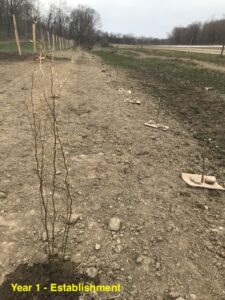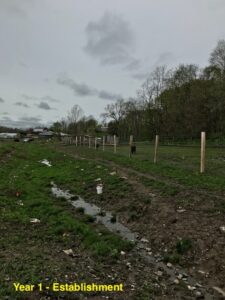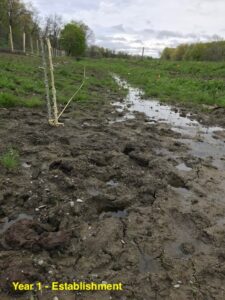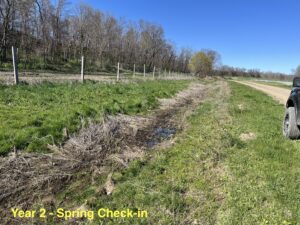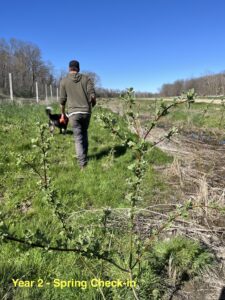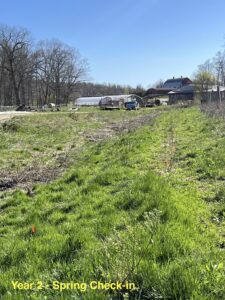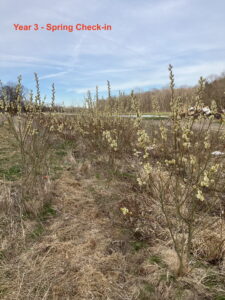Final report for ENE22-177
Project Information
Problem or Opportunity & Justification:
The agricultural sector in the Housatonic Valley (MA, CT, and NY) and Hudson River Valley (NY) must reduce its nutrient loading to improve water quality at the watershed level and meet EPA Clean Water Act standards for phosphorus. Many farmers believe there is a trade-off between farm income and ecologically beneficial agricultural practices (e.g. Kooistra et al. 2017, Liu et al. 2018). These perceptions can limit progress toward achieving environmental and conservation goals. Anecdotal evidence collected by the project leads from technical services providers in the Berkshires-Taconic region suggests that it is becoming increasingly difficult to identify farmers and landowners who are interested in reforesting their land. Increasing the awareness and technical skills of technical service providers (TSPs) to design multifunctional riparian buffers, like for-profit agroforestry or for pollinator habitat conservation, provides an opportunity to generate both water quality benefits, profits for farmers, and conservation outcomes for area land conservation organizations. Speaking to a farmer’s bottom line or the co-benefits of adding pollinator habitat can increase the probability that they want to plant riparian buffers on their land and the support for these services. However, there is a gap in technical service providers having the technical expertise to assist a farmer in how to design, install, and maintain these systems through maturity and beyond (20+ years).
Solution & Approach:
The project employed a cohort-based educational model over a two-year period, training TSPs from across the Berkshire-Taconic region and beyond. This project brought together industry experts to train local TSPs on how to design and implement multifunctional buffers for pollinator habitat and commercial agroforestry as a strategy for overcoming barriers to riparian buffer adoption. Each TSP received education on multifunctional riparian buffer design and implementation through webinars and in-person field days. In addition to these educational opportunities, most TSPs were able to create their own buffer designs, including planting plans, maintenance protocols, and discuss potential funding strategies with the cohort. Partner experts that were part of this project were also able to provide 1-on-1 consulting for TSPs that wanted to refine and improve their designs. This collaborative approach fostered inter-agency networking and peer learning, enhancing the potential for successful implementation.
Learning Outcomes:
Service providers participated in three full-day field events and four virtual training sessions, where they gained hands-on experience with multi-functional riparian buffer (MFRB) designs, pollinator habitat development, agroforestry practices, and farm conservation strategies. They developed and refined their own site-specific MFRB plans through peer review and expert feedback, and several were able to begin implementing these designs with farm clients during the '23 & '24 growing season. Additional learning resources, including two educational videos, four shareable PDFs, and personalized consultations, deepened TSPs technical knowledge and equipped them with practical tools to support farmers in adopting ecologically and economically beneficial riparian buffer systems.
Service Provider Actions/Outcomes:
As of this final report, at least two program participants have designed and implemented multifunctional riparian buffers for farmer clients in the Berkshire-Taconic region. 3+ projects are on deck to be implemented in 2025/26, pending approval of necessary funding. Some participating TSPs have reported that they continue to stay in touch, with a few folks regularly sharing information with each other related to buffers. In follow-up conversations with TSP participants, after their exit interview, they have shared that they have used at least one educational resource from this project (videos, PDFs, tables, etc.) to provide more information to farm clients that are interested in implementing riparian buffers on their farms.
Service Provider Performance Target: 30 agricultural service providers will prepare a total of 50 multi-functional riparian buffer plans with recommendations for clients in their service area. Plans will average 0.5 acres of buffer land or potential buffer land, and at least 25 acres of multi-functional riparian buffers will be designed, developed, or managed in the proposal target area.
Farmer Performance Target: Of 50 service provider plans created for clients, at least 20 clients will adapt management strategies to create or improve riparian buffers on their land, and at least 5 clients will fully implement SP plans (including design, installation, etc.) during the project time frame.
This project convened technical service providers (TSPs) across the Housatonic and Hudson River Valleys to address agricultural nutrient runoff, particularly phosphorus, that threatens regional water quality. Many farmers perceive a trade-off between profitability and ecologically sound practices, limiting conservation progress, and project leads noted growing difficulty in engaging landowners in reforestation efforts. These factors highlighted the need to better equip regional TSPs to discuss riparian buffers with the farmers they serve as both ecologically and economically beneficial. By enhancing regional TSP capacity to design multifunctional buffers, this project aimed to provide TSPs with the skills and knowledge necessary to align water quality goals with farm profitability and land stewardship.
Over two years, the project employed a cohort-based model to train TSPs in designing, installing, and maintaining multifunctional riparian buffers. Training included webinars, field days, and individualized consultations with expert partners. Participants developed their own buffer designs and explored funding strategies, while on-going peer learning is reinforcing long-term multifunctional riparian buffer implementation capacity.
Cooperators
- (Educator)
- (Educator)
- (Educator)
- (Educator)
Educational Approach
Engagement
Project partners drafted and published a formal request for participation through our partner organizations’ and regional TSP communication channels. The organizations contacted for our full proposal’s needs assessment were contacted directly. We gained commitment by building off existing organizational relationships and networks, and highlighted the expectation of this training opportunity as a two-year program to manage expectations from the outset. Participants were be supported through out the training via a group contact list, fact-sheet "library"/shared drive, creation of a series of educational videos, and the educational programming online and in the field. Berkshire Agricultural Ventures organized these materials in an easily shareable format (Google Drive) for participants to access and contribute to. 1-on-1 technical assistance budget was allocated to cover the time of key personnel in providing participants with on-call support as needed (capped at 4 hours per participant). Advisory committee members initially supported the project via outreach and recruitment through their own networks, and convened annually to assist with overall strategic project management.
TSP participants were required to identify a site to work towards creating a ‘shovel ready’ project - complete with planting design, owner outreach, funding strategy, and procurement plans by the end of two years. This cohort approach is specifically designed to encourage inter-agency collaboration and networking building beyond the timeframe of this grant funding.
Learning:
Educational Content:
(1) the process of designing, installing, and maintaining a multifunctional buffer (for-profit agroforestry buffer & pollination habitat focused buffers (2) the financial and ecological benefits of such buffers (3) Techniques for improving landowner outreach communication (4) Opportunities to leverage funding for these projects
Please see the ‘Curriculum Document’ in the supplementary materials for more information.
We used a multi-pronged approach to maximize the success of adult learning: in-person experiential, written information, visual with short online videos and diagrams, and opportunities for coaching/discussion through the cohort model.
- Cohort style learning: Group design review/design charrette workshop, with technical expert support and design review. Each participant will have up to 4 hours of 1:1 consulting with technical staff (Propagate Ventures & Landscape Interactions). Virtual and in-person educational cohort activities encouraged participants to solicit peer and expert feedback through the design process.
- In-person and in-situ education: on-farm workshop series with guest speakers; hosted three 6-hour in-person events (1 in 2023, 2 in 2024) at local demonstration sites practicing commercial and/or pollinator-focused riparian buffers. For a couple in-person events we were able to connect with local government funding agencies (i.e. NRCS and others) to attend and provide their insights with program participants.
- Virtual education: we hosted one winter webinar series (February ‘23) (three days; 3-hour morning meetings) with guest speakers followed by group discussion - these webinars focused on design principals & associated funding opportunities.
- Open-source educational materials: We created evergreen educational materials to share with program participants and publicly (including beyond the geographic scope of this project). These materials include multiple PDFs explaining design processes for multifunctional buffers, as well as educational videos to help visualize the process and share the stories of farmers/landowners who have adopted these practices. We recorded our virtual events and will publicly house the recordings on BAV’s website for the next five years (through 2030).
Evaluation
Our project used a pre-project online survey of participating service providers to first establish baseline knowledge, skills, and awareness of multifunctional riparian buffer planning, design, and implementation. The pre-project survey was conducted April 2022 as cohort members applied to the program. A final and more extensive post-project survey, using the same questions as the pre-project survey, was conducted during the Summer of 2024 to collect accurate pre-and post-project evaluation data. Ben Crockett was primarily responsible for survey development, with support from advisory committee members as necessary. Outcomes from these surveys and participant feedback (captured in more detail later in this report) suggest various needs and opportunities for further development around multifunctional riparian buffers, most notably ongoing assistance navigating funding support for conservation/climate-smart practices, deepening relationships with farmers to increase likelihood of buffer implementation, more plant ID and MFRB plant resource lists.
Milestones
- Engagement: Outreach to 50+ service providers in grant area. 30 service providers apply and commit to the 2 year training program and follow up reporting in 2025. Outreach will occur in March through May of 2022. Outreach and registration will be led by Ben Crockett with outreach support from Dan Carr and other BAV staff, Propagate Ventures, Landscape Interactions and the Advisory Committee.
- Status: Complete - April 2022
- Accomplishments: Outreach to 15 individuals and 12 groups and listservs, approximately sharing a request for applicants to the program with 40-50 individuals. After initial outreach 18 service providers signed up to complete the program. Original assumption of interested service providers proved to be much lower than anticipated during project proposal development phase, with 2 primary factors contributing to limited interest. A lack of available CEUs or similar professional development and continuing education credits meant that some service providers that were interested in participating could not, since they had a limited number of professional development trainings they can complete each year, and need to prioritize completion of CEUs for employment and/or existing accreditation. Service providers also have many different programs they can participate in each year and have to prioritize professional development opportunities that best align with their current roles and responsibilities. Given the subject focus of this program, combined with the multi-year timeline for the program, multiple interested service providers were deterred from participating if they did not need to complete the program for their current role.
- Engagement: 30 service providers will be organized into 10 groups of 3, and each team will decide on one riparian buffer site (average 3 acres per site) to serve as their case study project through the training program. This will occur in May and June of 2022. Ben Crockett will lead with support from Dan Carr and Mark Phillips.
- Status: Complete - August 2022
- Accomplishments: Given the smaller group of service providers that participated in the program, Ben Crockett and Mark Phillips discussed with those enrolled in the program if they would like to work in teams or individually for their case study during the first program meeting. Program participants decided that they wanted to work individually, as many providers were already working with farms, or anticipated working with farms in the near future, that were interested in developing riparian buffers.
- Learning: 30 service providers participate in three, 3-hour in-person events. These will take place in Summer of 2022 and Spring and Summer of 2023. Coordination of events by Ben Crockett with multiple presenters including project partners and host site personnel.
- Status:Complete - October 2023
- Accomplishments: 3 field days, often taking up the majority of a day (6-8 hrs), were held in August 2022, and August and October of 2023. Due to the novelty of multi-functional riparian buffers (MFRBs) as a farm practice in the Northeast region for this project, a variety of sites associated with online/classroom work were visited by program participants to see elements of MFRB design in practice. Sites visited:
- Great Wonder Farm (Livingston, NY) - Site visit led by Audrey Epp Schmidt and Mark Phillips on behalf of Propagate Ag who oversees management of the farm. The visit showcased agro-ecological design principles, species selection and productive crops (harvest-able) that could be utilized in MFRBs.
- Bard College (Red Hook, NY) - Site visit was led by Evan Abramson and focused on site analysis and design of agricultural land for at-risk pollinator species. Bard College aims to transition an old corn field it owns into pollinator friendly habitat, including a planting of pollinator-friendly plant species in an area with exceptionally wet soils in a field adjacent to Sawkill Creek.
- Siuslaw Model Forest (Acra, NY) - Site visit led by Tracey Testo Smith, Agroforestry and Natural Resources Program Manager for Columbia & Greene CCE. Program participants learned about non-timber forestry products that could be produced in or adjacent to riparian areas of the forest.
- Hawthorne Valley Farm (Ghent, NY) - Site visit led by farm manager Spencer Fenniman focused on how dairy cow pasture systems on the farm have been improved along (and crossing) Agawamuck Creek and other seasonal streams on the farm. This riparian buffer work was supported by the Farmscape Ecology Program and cost sharing from Columbia county Soil & Water Conservation District (S&WCD). Dylan Cipkowski from Columbia S&WCD provided participants with background on how the projects at Hawthorne Valley Farm came together in partnership with S&WCD, and how farms can work with conservation districts and federal partners (e.g. NRCS) to address resource concerns in riparian areas.
- French Park (Egremont, MA) - Site visit co-led by Evan Abramson and Elizabeth Keene (of Indian Line Farm) focused on their collaboration with the town of Egremont to develop pollinator habitat at French Park, including in low and wet areas of the (primarily turf) site. Participants learned about minimum planting amounts to create sufficient pollinator habitat, working with municipalities and communities to ensure maintenance plans were in place before installation, and planting pollinator habitat with a limited budget.
- Arthur's Point Farm (Ghent, NY) - Site visit led by farm owners David Newman and Stephanie Lazar, who have started to improve riparian areas on their farm after purchasing the farm in 2020. In an effort to reduce erosion and maximize the utility of farmland in low-lying riparian areas the farm has planted various mast (nut) tree species, and experimenting with various techniques (stick, bundle, etc.) for establishing various species of willows.
- Whistle Down Farm (Hudson, NY) - Site visit led by farm owner/operator Nicholas Pandjiris, who is an experienced crop and nursery producer. Nicholas shared some of the work he's done on the farm in recent years, with more focus on perennials and woody-plant crops, and his perennial inter-cropping trials he completed as part of a recent SARE Farmer project. Of particular note were Nicholas' efforts to stabilize a steep river bank adjacent to his property with a diversity of tree species he had grown or sourced himself.
- Bartholomew's Cobble (Sheffield, MA) - Site visit led by Dr. Julie Richburg, the Lead Ecologist for Inland Natural Resources with The Trustees (of Massachusetts). At "Bart's Cobble" Julie was part of a significant riparian buffer planting and has been studying it's success for over 15 years. Julie discussed the various planting techniques The Trustees used to establish the riparian buffer and some of the challenges they've faced with the maintaining the plantings (e.g. beaver pressure). This site was also helpful to participants because they could stand in a mature riparian buffer and look across the Housatonic River to dent corn planted right to the edge on the opposing river bank.
- Learning: 30 service providers participate in 4, half-day virtual training sessions. This will occur Winter of 2022/23. Led by M. Phillips and E. Abramson. Dan Carr and Ben Crockett will support.
- Status: Complete - February 2023
- Accomplishments: The timing of virtual training sessions shifted slightly, with program organizers deciding that it would be helpful to hold one online meeting in August 2022. This served as a way for participants to connect and share about their interests in riparian buffers and how they can be utilized to provide more functionality to farms. It also was an important introduction to ground the group in the principals of riparian buffer design and implementation, and how multiple benefits and products could come from the establishment of riparian buffers, addressing a common concern that riparian buffer land is considered to be "taken out of production". The other three session happened during the month of February 2023, with sessions happening every Wednesday for 3 consecutive weeks. The first winter session, led by Evan Abramson from Landscape Interactions, was focused on developing riparian buffers that improve biodiversity, pollinator food sources and habitat, and mitigate flood risks. The second session was led by Seth Gillim and Ranan Sokoloff from the Propagate Ag. team and centered around developing a riparian buffer plan. Importantly, Seth and Ranan discussed some of the trickier aspects of establishing multi-functional riparian buffers, like ensuring that post-installation and care is carried out by the farm, and strategies for determining the financial implications of installing multi-functional riparian buffers. During the first two sessions participants were given instructions and support on beginning their own multi-functional riparian buffer designs for their case study. Participants created designs using whatever tools were most accessible to them (paper & markers, various computer programs, etc.), with emphasis put on thinking through the elements of a multi-functional riparian buffer, not learning a new design program (although some participants took it as an opportunity to explore and experiment with new design media). During the third session participants took turns sharing their designs, followed by a group discussion about the design, similar to a writing workshop. Discussions proved to be fertile ground for troubleshooting, new ideas, and general peer to peer learning.
- Associated learning materials:
- Learning: 2, 2-3 minute videos are created and shared with the cohort. These will be completed by January 2025. Ben Crockett will coordinate with Forge Media who will film, edit, and publish these videos.
- Status: Complete - February 2025
- Accomplishments: As noted in other parts of this report, although there are a few examples of riparian buffers in the Berkshire-Taconic region, examples of multi-functional riparian buffers are very limited. Similar to trying to identify appropriate, and ideally mature (10+ years old), examples of multi-functional riparian buffers for the field days, finding examples to film was even more challenging (and time consuming). The filming company we are working with, Forge Media (Poughkeepsie, NY), has been very gracious, patient, and supportive through the process as well. They have offered their expertise in creating video content that will highlight the concepts provided to program participants, and are always ready to pivot as filming plans have been reconfigured multiple times.
- Throughout 2024 Ben Crockett coordinated filming with the Forge Media team to create one animated video explaining the basic concepts of multi-functional riparian buffers, and one video featuring 2 farmers who installed MFRBs to share their experiences with MFRBs. By coincidence, both farmers that were willing to participate in the recordings had also worked through the same Soil & Water Conservation District office in Dutchess county (NY), and this created an opportunity to interview Soil & Water team members that helped design and install these buffers (including one service provider who was part of the service provider cohort group for this MFRB grant project). The videos have undergone final reviewing and editing processes between Forge Media and PI Ben Crockett, web hosting will be finalized by the end of March 2025, and both videos will be ready to share out with the MFRB service provider cohort and wider public by April 1st.
-
Use the following links to access the videos:
- Learning: 4 shareable PDFs are created and shared with the cohort and publicly through social media and other listservs during the Winter of 2022/23. Evan Abramson will produce 2 PDFs focused on pollinator habitat education. Mark Phillips and Audrey Epp Schmidt will produce 2 PDFs with education on permanent crops and economic considerations of riparian buffers.
- Status: Complete - February 2023
- Accomplishments: Multiple resources were produced from this program, ideally to bolster the tools service providers have when communicating with the farms they support about implementing riparian buffers.
- These 4 PDFs along with a number of other resources were created over the course of the program:
- "Introduction to Multi-functional Riparian Buffers" (Mark and Audrey of Propagate) - Intro_MFRBs
- "Species & Management Considerations For Profitable Multi-functional Riparian Buffers" (Seth and Ranan of Propagate) - Considerations For Profitable Multi-functional Riparian Buffers
- "Riparian Buffers as Habitat" (Evan of Landscape Interactions) - Riparian Buffers as Habitat
- "Farming for Biodiversity - Island Grown Farm case study" (Evan of Landscape Interactions) - Farming for Biodiversity
- MFRB Plant Material Sources List - Plant Material Sources
- Pollinator Plant List
- MFRB Resources for Service Providers
- Learning: 20 service providers participate in a minimum of 1-hour virtual consultations (phone or video) with Landscape Interactions or Propagate Ventures by December 2024 (maxed at 4 hours per participant).
- Status: Complete - July 2024
- Accomplishments: Due to the lower than expected number of participants, each participant was encouraged to use at least 4 hours, with an option for additional hourly approval depending on availability of remaining hours for each consultant. This part of the program had low interest among participants, but provided an opportunity for the few participants that did utilize these consultations to receive deeper and more concerted support, improving their case study designs and offering feedback on additional farm client projects related to riparian buffer plantings.
- Learning: By last field day in Summer 2023 cohort teams finalize their site designs. Plans reviewed by Evan Abramson, Mark Phillips, and Ben Crockett by September 1st, 2023
- Status: Complete - February 2023
- Accomplishments: Given the low number of participants, and progress that was made during online sessions in February 2023, participants reviewed each others site designs with support from Evan, Mark, and Ben. It was also helpful to complete the site designs in February because a few service providers were able to take those designs and begin to implement them in the 2023 growing season with the case study farms they were working with.
- Evaluation: 5 different surveys are sent out across the grant period, with 90% participation by SP program participants (led by Ben Crockett with input from Mark Phillips and Dan Carr). Surveys will evaluate SP knowledge around riparian buffers before training, during, and after training is complete, as well as a year after training ends to report on how SPs have integrated riparian buffer plans into their client recommendations. Participants will also be surveyed at the end of training on quality of training, overall program offerings, and possible future needs. An optional survey will be sent to SPs that can report back on implementation of buffers on client sites late in 2024.
- Status: Complete - October 2024
- Accomplishments: Surveying to evaluate SP knowledge regarding riparian buffers was modified to capture pre- and post-training, with in-session verbal check-ins with participants to modify course content or delivery as needed to suit the cohort. Post-training surveys were delivered to participants in June 2024, and the last post-training survey was received at the end of October 2024. Initially we had 16 applicants, on average reporting a confidence level of 2.75 on a 1 to 5 scale from the question "How confident are you in your current understanding of riparian buffers and how multifunctional plants can contribute to improved farm, land, and water management outcomes?". Of the 10 participants that completed 75% or more of the program, when asked the same question after completing the program, they had an average confidence response of 3.82. This may be attributed to factors outside of what the programming offered (e.g. those with more interest or professional support to attend all sessions), but when trying to control for those differences and evaluate average individual increases, there was an average self-reported confidence increase of .9 per participant. It most likely varies between participants what parts of the programming contributed to the improved confidence levels, but looking for patterns in participant exit interview responses, there was an emphasis on the importance of networking with other service providers addressing similar problems, and having a community of practice to brainstorm with on designs and implementation approaches. For those with some background in riparian buffer design already, they shared the benefit of getting to see more examples in the field combined with the presentations on MFRB plant options and how to support clients through MFRB project management (design, planning, financing). More feedback on future needs identified during exit interviews are provided in other areas of this report.
- Evaluation: The advisory committee will be convening on a bi-annual basis to review surveys and to inform any adjustments to the curriculum that come from that participant feedback, allowing an opportunity to adaptively manage the project. (organized by Ben Crockett).
- Status: Complete - March 2023
- Accomplishments: The three person advisory committee was an important sounding board for this project, especially because the principal investigator (Ben), was new to the region and unfamiliar with regional needs and potential sites to showcase multi-functional riparian buffer principals. Participant feedback and curriculum adjustments were discussed, but the dominant (and most helpful) conversations with the advisory committee were focused on identifying appropriate sites to study and visit with participants.
- Evaluation: All participants partake in an exit interview with key personnel, Ben Crockett.
- Status: Complete - November 2024
- Accomplishments: 10 exit interviews (out of 21 total participants) were conducted by Ben Crockett with service provider participants between July and November of 2024. Interviews averaged 30 minutes, and participants were asked to reflect on the value of this program, how the training changed their understanding of MFRBs, the need for additional tools and resources on MFRBs, effectiveness of program delivery, and how participants would change or update this programming to be better in the future. Ben Crockett annotated conversations on shared Google Documents, and gave each interviewed participant access to these notes to edit as needed as a way to ensure their feelings and feedback on the program were accurately captured.
Milestone Activities and Participation Summary
Educational activities and events conducted by the project team:
Participants in the project’s educational activities:
Learning Outcomes
Performance Target Outcomes
Performance Target Outcomes - Service Providers
Target #1
12
Provide recommendations on site evaluation, integration of holistic farm goals, plant species selection, and other factors for farmers to successfully implement multi-functional riparian buffers.
20
unknown at this time
9
12
Service providers worked with all size/scales of farms in their region, ranging from 2 acres to 150+ acres
- 1 Curricula, factsheets and other educational tools
- 4 Consultations
April 2025: As shared earlier in the 'Milestones' section, of the initial 16 applicants to the program, on average they reported a confidence level of 2.75 on a 1 to 5 scale from the question "How confident are you in your current understanding of riparian buffers and how multifunctional plants can contribute to improved farm, land, and water management outcomes?" at the beginning of the program. Of the 10 participants that completed 75% or more of the program, when asked the same question after completing the program, they had an average confidence response of 3.82. Various reasons probably contribute to this shift, as hypothesized in the 'Milestones' section, but this data also aligns with patterns that emerged from participant exit interviews. For example, field visits were generally seen as a critical part of the training, helping participants see the practices "in action" and better visualize the application of MFRB practices across a diversity of sites. Another common benefit was the widening of participants' understanding of what is possible and beneficial in riparian areas, especially in agricultural settings. Most participants appreciated the hybrid educational approach (Zoom meetings and field days) to the program, finding it to be a good balance of info-heavy sessions during the colder months, and in-person field days with classmates during the growing season. Although we fell short on the number of participants we had hoped to reach, it seems enough valuable learning opportunities were coordinate to achieve this project's goal of crafting a regionally-adapted training program that fosters networking amongst technical service providers to accelerate the adoption by farmers of multi-functional riparian plantings.
Feb 2025: Service provider exit interviews and surveys were the primary way that information was collected to verify performance target outcomes. Getting firm numbers was sometimes difficult due to the variety in the work each service provider performs, and clearly identifying where information from this program was applied or integrated wasn't always clear in participant responses. Some participants had clearly talked with farmers and other service providers about what they had learned in the program, and from exit interviews it can be inferred that some program and planning changes had been implemented based on program materials and trainings. Other times, especially for service providers that were already practicing some form of riparian buffer planning or assistance to farmers, it was less clear how the programming materials led to greater implementation of MFRBs, but it did seem that the programming augmented the work that these service providers were already doing in their day-to-day jobs. It seemed pretty clear from exit interviews and surveys that no service providers had used the materials to facilitate on-farm demonstrations, tours, webinars, or other educational events. That said, it was also clear that much of the program materials and experiences have enhanced service providers consultations with farmers and landowners, and augmented their understanding of best practices and design possibilities presented to the clients they support.
Some examples of feedback from program participants:
"(This program) helped me to understand how big the buffers can actually be. Previously I only understood the "standard" 35-50’ width buffer approach (conservation buffers), but looking at MFRBs, helped me realize I can design buffers at a larger (wider) scale."
"I had heard about “multi-functional” prior to this program, but I hadn’t considered their complexity... it was helpful to think more about the food, pollinators, and other benefits that could come from riparian buffers."
"(It would have been better to have) a partner-farmer engaged with me in the training - if there could be a flexible commitment with an engaged (farmer) stakeholder during the program that would be a really powerful way to better understand implementation and practicality of what we learned in the program."
Jan 2024: At least one farm has been supported by a participating service provider to design and implement a cost-effect multi-functional riparian buffer. This project integrated willows and other plantings in a buffer around a small stream dividing two active pastures, including temporary exclusion to allow new plant materials to establish. At maturity planting will provide improved riparian area health and provide fodder/forage for grazing animals on the farm. Added benefit of engaging with farmer to temporarily exclude during establishment, and permanently limit beef herd access to stream to reduce erosion and pollution due to cattle being in the stream to drink. Other projects are in the works for 2024, and hope to have more to report back on related to on-farm projects and service provider outcomes after completing "exit interviews" with program participants during Summer '24.
Jan 2023: This program and the service providers participating are still in the early learning stages, and data to capture how education and resources are distributed by service providers based on this program have not yet been collected.
Project Example:
In this riparian area, formerly accessible by cattle, fencing has been installed to exclude cattle and a program participant installed woody plants to establish a permanent riparian buffer.
Inspecting survival rates and plant development in new riparian buffer area approximately 1 year after establishment.
Picture of third year growth of willows and other plants used to create the same riparian buffer, 2 years after establishment
Performance Target Outcomes - Farmers
Target #1
10
Develop, design, and implement multi-functional riparian buffers on managed farms
1-100+ acres in production
3
2 - 120+ acres
Additional Project Outcomes
April 2025: As the project fully comes to a close, it's great to end on the high note of providing two excellent videos produced by Forge Media! These videos should provide service providers with a simple way to share the ideas of multi-functional riparian buffers with farmers and landowners. For individuals that are doing their own research, they provide a great overview of the practice, considerations, and feedback from other farmers who have tried out the practices on their own land.
Use the following links to access the videos:
Multi-functional Riparian Buffers 101
Feb 2025: In addition to the exit interviews with participants, the development of two short videos for participants and other service providers to use was the big outcome for 2024. Coordinating the filming proved to be more complex than originally anticipated, but with support from Forge Media the creation of "MFRB 101" and "Farmer Interviews" videos were completed by early 2025. This also was a great way to connect with some farmers that are actually implementing multi-functional riparian buffers, learn about the how these projects are implemented on different farms, and better understand the support they need to complete these projects (design, plant selection, plant materials, and installation labor). The hope with these videos is they provide a simple and easy way to share the MFRB practice with more farmers that may be interested and unaware of the practice, as well as provide some level of "farmer to farmer" dialogue about real farmers experiences implementing MFRBs on the lands they manage.
Jan 2024: A few notable outcomes as the training portion is complete heading into 2024. Participants who were able to participate in all 3 on-line sessions during February, and completed their own multi-functional riparian buffer design, reported be much more comfortable discussing MFRB design with farm clients. At least one design completed during February sessions was implemented during the 2023 season - there is also on-going design work (with service provider TA provided by project partners) for another farm hoping to implement a buffer in 2024. One participant is utilizing their allotted TA hours for support creating public resource "Native Pollinator Plants for Vermont Farms" for 2024.
Jan 2023: Due to the early stages of this project it has not been utilized to access external grant funding. One on-going collaborator that this project connected with is the Hudson Valley Climate Action Network (HVCAN) via our field day at Bard College.
Feb 2025: We were not able to collect any quotes from farmers that were beneficiaries of the training that service providers received from this program, but some quotes from the exit interviews illuminates how this program is increasing awareness and building a network of practitioners implementing MFRB practices:
"I really enjoyed this offering and benefited greatly in a professional capacity. The resources and organizations that were connected to us during this work were shared throughout my community. I found the greatest value to be the field tours, which gave exposure to these buffer systems at various stages of establishment."
"(This programming helped me get) a better understanding of how riparian buffers actually work."
"The value was really in seeing (MFRBs), and seeing what it looks like in practice - learning from the people that are actively doing it, and learning from their experiences. This helps paint a better picture in my mind of what MFRBs would like in practice and communicate that with my clients."
"The push to make a plan was great. It made me get more 'concrete' about the riparian buffer planning process."
"It was helpful to talk with service providers from other states, and learn about how other states fund these projects, and the various challenges and solutions they’ve found in similar projects."
"The thing that I liked most about the training was the connections made between service providers in the program. The types of people that came together were very valuable, and through those relationships I was able to expand service to farms in my area around riparian buffers."
Jan 2024: It was exciting to see one participant, even though they joined the cohort late, go from design to implementation. This participant used an existing relationship with a local beef operation to discuss, design, and install a low-cost multi-functional riparian buffer within a matter of months. It will be interesting to see how successful the planting has been after one year! I know there are at least a handful of other participants that are in active conversations with farm clients going into the 2024 growing season, and hope to report back more success stories in our final report next year.
We also had two great field days in August and October which were an enjoyable way for the group together and explore existing MFRB-related projects in our region. Despite there being a limited number of farms actively utilizing MFRBs, the collection of sites participants were able to explore generated a lot of discussion, deeper understanding of riparian buffer plant species, and new networks between farmers and service providers.
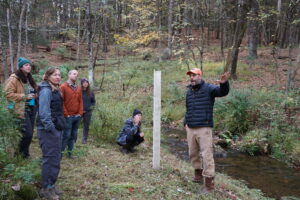
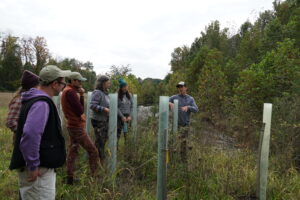
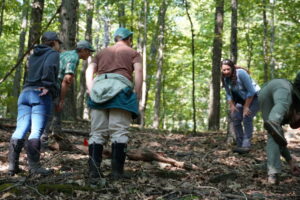
Jan 2023: After the 2022 field day, participants were asked, "What is the best, or most valuable, part of the MFRB training so far?"
A sampling of responses:
- "Seeing example plantings and plans first hand."
- "Collective shared resources"
- "Connecting with other participants and with speakers"
- "Being able to focus more deeply on a specific adaptation practice and see first hand the challenges in the field (literallly!)
Feb 2025: During exit interview, participants identified multiple areas of further study or resource development that they need to further implement MFRBS;
- Resources on available funding is always needed - creating or identifying a central location to compile funding streams and grant opportunities
- Hosting a panel of farmers that have accessed funding and implemented riparian buffers
- Redoing this type of training with service provider/farmer pairings and funds to implement designs
- Additional guidance on how to talk to farmers about these practices
- Having materials to hand to farmers (more hands on, paper materials)
- More plant ID related training would be helpful - there may be maps where plantings are marked, but important for technical assistance providers to be able to quickly identify desirable riparian species in the field, especially for older plantings they may not have been involved in installing
- Would be helpful to have some easier templates/use-cases to introduce the design process
- On going education, especially around riparian tree species
- "Don’t feel like I need more tools or information - rather there just needs to be more funding for the practice..."
Jan 2024: A pattern that has started to emerge in this and other programs is a need for earlier in-person gatherings. If folks are meeting eachother for the first time online, it is harder to develop a trusting community of practice that will fully utilize on-line workshops that include peer-2-peer feedback. Although everyone in the group was respectful and supportive, the real energy of this learning cohort didn't emerge clearly until our 2nd field day. Online working can still work with out in-person connections to start, but in-person connections prior to online learning seem to encourage more productive online sessions.
This project has also brought about the questions of "who is a service provider?" - at least two participants identified primarily as farmers even though they have a history of providing their agricultural services to off-farm clients. Though they don't have a formal title or academic background that often denote who is considered an agricultural service provider, but they are just as valuable for broadening adoption of sustainable farming practices in their communities, and might even have an advantage over 'traditional' service providers since there is a lower barrier to establish trust with a peer farm manager.
It required a bit of creativity to provide valuable field day experiences that were accessible to a majority of the participants. There are a limited number of MFRB examples in the target region for this grant, and funding was not requested to transport participants further outside the region. To meet this challenge field-days instead comprised visits to 3 sites each day (total of 6 in 2023) to see a variety of scenarios and practices on farms throughout the Berkshire-Taconic region. Each site emphasized a component of a MFRB as discussed during the Winter '22/'23 sessions, even though all but one site had an existing MFRB. Given the amount of coordination required for each field day, especially given that one had to be completely rescheduled due to flooding in July 2023, it would have been better to at least have a list of appropriate size prepared when applying for the grant.
Jan 2023: At this stage of the project we've had the opportunity to test out a hybrid delivery method. Our first online session was helpful in getting us started, increasing accessibility to our community of service providers covering a large multi-state area, and easily being able to resources. As many have noted since the changes to meetings and delivery methods since COVID-19, despite the ease to engage digitally, a strong demand for engaging in person was shared by participants and project partners alike. Our first in-person field day offered that opportunity, but also introduced other challenges - namely demands on participant's time to travel to multiple sites, and physical accessibility for some participants during certain parts of the field day. For the remainder of this project the grant lead will make additional efforts to "dry-run" field days and understand site access. For future project budgets it will be important to account for compensation of participant mileage when the project involves site visits. Additionally, despite the demand and interest in more field days and site visits by participants, it has been difficult to identify appropriate mature sites with multifunctional riparian buffer plantings to share with participants due to the relative novelty of MFRBs on farms in the project area.
